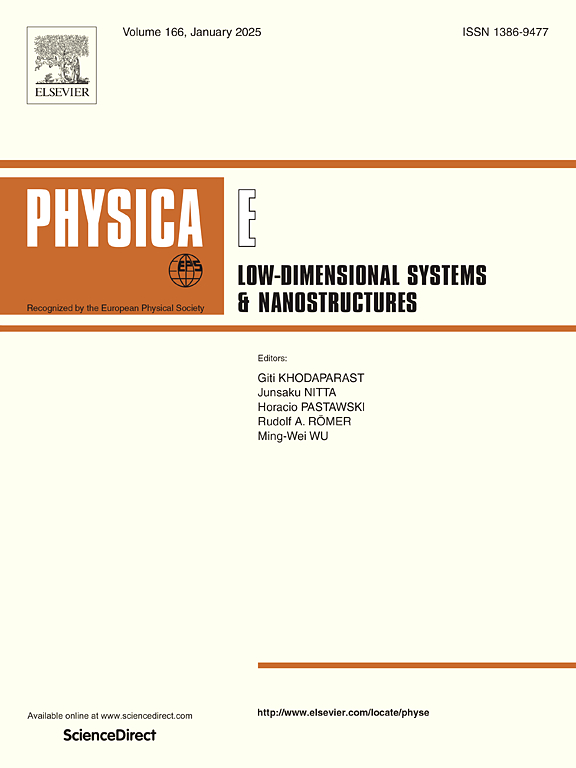Determining the purity of single-helical proteins from electronic specific heat measurements
IF 2.9
3区 物理与天体物理
Q3 NANOSCIENCE & NANOTECHNOLOGY
Physica E-low-dimensional Systems & Nanostructures
Pub Date : 2025-06-02
DOI:10.1016/j.physe.2025.116288
引用次数: 0
Abstract
We present a theoretical investigation of the electronic specific heat (ESH) at constant volume () of single-helical proteins modelled within the tight-binding (TB) framework. We study the effects of environment and biological defects on thermal properties of single-helical proteins. We employ a general TB model to incorporate all parameters relevant to the helical structure of proteins including the long-range hopping. In order to provide additional insights into our results for the ESH, we also study the electronic density of states for various disorder strengths. We observe that the variation of the specific heat with disorder is very different in low and high temperature regimes, though the variation of ESH with temperature possesses a universal pattern upon varying disorder strengths related to environmental effects. Lastly, we propose an interesting application of the ESH spectra of proteins. We show that by studying the ESH of single-helical proteins, one can distinguish a defective sample from a pure one. This observation can serve as the basis of a screening technique that can be applied prior to a whole genome testing, thereby saving valuable time & resources.
用电子比热法测定单螺旋蛋白的纯度
我们提出了一个理论研究的电子比热(ESH)在恒定体积(Cv)的单螺旋蛋白在紧密结合(TB)框架内建模。我们研究了环境和生物缺陷对单螺旋蛋白热性能的影响。我们采用了一个通用的结核模型,以纳入与蛋白质的螺旋结构有关的所有参数,包括远程跳跃。为了对ESH的结果提供更多的见解,我们还研究了不同无序强度的态的电子密度。我们观察到,在低温和高温条件下,比热随无序的变化有很大的不同,尽管ESH随温度的变化在与环境效应相关的不同无序强度上具有普遍的模式。最后,我们提出了蛋白质的ESH光谱的一个有趣的应用。我们表明,通过研究单螺旋蛋白的ESH,可以区分有缺陷的样品和纯净的样品。这一观察结果可以作为一种筛选技术的基础,这种技术可以在全基因组检测之前应用,从而节省宝贵的时间。资源。
本文章由计算机程序翻译,如有差异,请以英文原文为准。
求助全文
约1分钟内获得全文
求助全文
来源期刊
CiteScore
7.30
自引率
6.10%
发文量
356
审稿时长
65 days
期刊介绍:
Physica E: Low-dimensional systems and nanostructures contains papers and invited review articles on the fundamental and applied aspects of physics in low-dimensional electron systems, in semiconductor heterostructures, oxide interfaces, quantum wells and superlattices, quantum wires and dots, novel quantum states of matter such as topological insulators, and Weyl semimetals.
Both theoretical and experimental contributions are invited. Topics suitable for publication in this journal include spin related phenomena, optical and transport properties, many-body effects, integer and fractional quantum Hall effects, quantum spin Hall effect, single electron effects and devices, Majorana fermions, and other novel phenomena.
Keywords:
• topological insulators/superconductors, majorana fermions, Wyel semimetals;
• quantum and neuromorphic computing/quantum information physics and devices based on low dimensional systems;
• layered superconductivity, low dimensional systems with superconducting proximity effect;
• 2D materials such as transition metal dichalcogenides;
• oxide heterostructures including ZnO, SrTiO3 etc;
• carbon nanostructures (graphene, carbon nanotubes, diamond NV center, etc.)
• quantum wells and superlattices;
• quantum Hall effect, quantum spin Hall effect, quantum anomalous Hall effect;
• optical- and phonons-related phenomena;
• magnetic-semiconductor structures;
• charge/spin-, magnon-, skyrmion-, Cooper pair- and majorana fermion- transport and tunneling;
• ultra-fast nonlinear optical phenomena;
• novel devices and applications (such as high performance sensor, solar cell, etc);
• novel growth and fabrication techniques for nanostructures

 求助内容:
求助内容: 应助结果提醒方式:
应助结果提醒方式:


